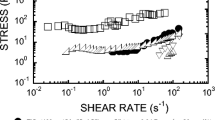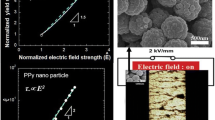Abstract
Particles of polyaniline protonated with perfluorooctanesulfonic acid provided a material with hydrophobic surface. This property enabled its perfect dispersion in silicone oil due to its good compatibility with the hydrophobic medium. In contrast, in a suspension of hydrophilic polyaniline particles doped with sulfamic acid, strong interactions of particles prevailed, which led to the formation of entangled chains of aggregated particles in suspension. The difference in structural properties of suspensions exists already in the absence of electric field and significantly influences their electrorheological behavior after application of electric field. The formation of electrorheological structure has been monitored by recording time dependences of the shear stress and the electric current passing through the flowing suspensions.









Similar content being viewed by others
References
Block H, Kelly JP (1988) Electro-rheology. J Phys D Appl Phys 21:1661–1677
Jordan TC, Shaw MT (1989) Electrorheology. IEEE Trans Electr Insul 24:849–878
Blackwood KM, Block H (1993) Semi-conducting polymers in electrorheology: a modern approach to smart fluids. Trends Polym Sci 14:98–104
Parthasarathy M, Klingenberg DJ (1996) Electrorheology: mechanisms and models. Mater Sci Eng R 17:57–103
Hao T (2001) Electrorheological fluids. Adv Mater 13:1847–1857
Hao T (2002) Electrorheological suspensions. Adv Colloid Interface Sci 97:1–35
Sung JH, Cho MS, Choi HJ, Jhon MS (2004) Electrorheology of semiconducting polymers. J Ind Eng Chem 10:1217–1229
Quadrat O, Stejskal J (2006) Polyaniline in electrorheology. J Ind Eng Chem 12:352–361
Block H, Kelly JP, Qin A, Watson T (1990) Materials and mechanisms in electrorheology. Langmuir 6:6–14
Choi HJ, Cho MS, To K (1998) Electrorheological and dielectric characteristics of semiconductive polyaniline-silicone oil suspensions. Physica A 254:272–279
Ikazaki F, Kawai A, Uchida K, Kawakami T, Edamura K, Sakurai K, Anzai H, Asako Y (1998) Mechanisms of electrorheology: the effect of the dielectric property. J Phys D Appl Phys 31:336–347
Marschall L, Zukovski CF IV, Goodwin JW (1989) J Chem Soc Faraday Trans 85:2785–2795
Lengálová A, Pavlínek V, Sáha P, Quadrat O, Kitano T, Stejskal J (2003) Influence of particle concentration on the electrorheological efficiency of polyaniline suspensions. Eur Polym J 39:641–645
Choi HJ, Jhon MS (2009) Electrorheology of polymers and nanocomposites. Soft Matter 5:1562–1567
Jang WH, Kim JW, Choi HJ, Jhon MS (2001) Synthesis and electrorheology of camphorsulfonic acid doped polyaniline suspensions. Colloid Polym Sci 279:823–827
Stejskal J, Prokeš J, Trchová M (2008) Reprotonation of polyaniline: a route to various conducting polymer materials. React Funct Polym 68:1355–1361
Stěnička M, Pavlínek V, Sáha P, Blinova NV, Stejskal J, Quadrat O (2009) The electrorheological efficiency of polyaniline particles with various conductivities suspended in silicone oil. Colloid Polym Sci 287:403–412
Lee JH, Cho MS, Choi HJ, Jhon MS (1999) Effect of polymerization temperature on polyaniline based electrorheological suspensions. Colloid Polym Sci 277:73–76
Stěnička M, Pavlínek V, Sáha P, Blinova NV, Stejskal J, Quadrat O (2010) Effect of hydrophilicity of polyaniline particles on their electrorheology. Steady flow and dynamic behaviour. J Colloid Interface Sci 346:236–240
Lengálová A, Pavlínek V, Sáha P, Stejskal J, Quadrat O (2003) Electrorheology of polyaniline-coated inorganic particles in silicone oil. J Colloid Interface Sci 258:174–178
Stejskal J, Gilbert RG (2002) Polyaniline. Preparation of a conducting polymer (IUPAC technical report). Pure Appl Chem 74:857–867
Acknowledgements
The authors thank the Ministry of Education, Youth and Sports of the Czech Republic (MSM 7088352101), the Grant Agency of the Czech Republic (202/09/1626), and the Grant Agency of the Academy of Sciences of the Czech Republic (IAA 400500905) for the financial support.
Author information
Authors and Affiliations
Corresponding author
Rights and permissions
About this article
Cite this article
Stěnička, M., Pavlínek, V., Sáha, P. et al. Structure changes of electrorheological fluids based on polyaniline particles with various hydrophilicities and time dependence of shear stress and conductivity during flow. Colloid Polym Sci 289, 409–414 (2011). https://doi.org/10.1007/s00396-010-2357-9
Received:
Revised:
Accepted:
Published:
Issue Date:
DOI: https://doi.org/10.1007/s00396-010-2357-9




